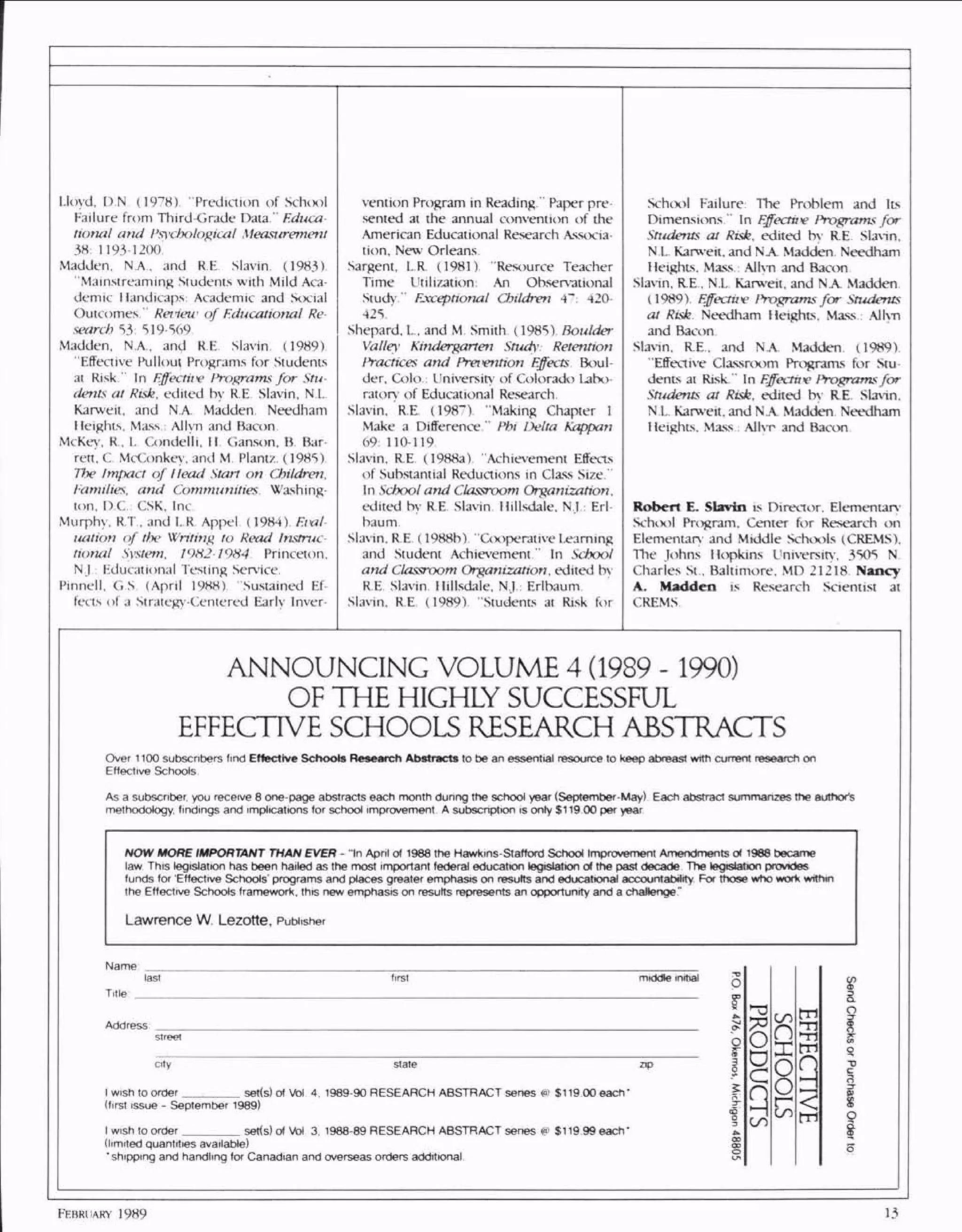The document discusses effective instructional practices for helping at-risk students achieve academic success, emphasizing that failure often results from schools' inability to meet diverse needs rather than student incapacity. It critiques common strategies like retention and pullout programs, highlighting their limited effectiveness, and recommends exploring prevention, classroom change, and remediation as more viable approaches. The authors conclude that tailored, early intervention strategies can significantly improve educational outcomes for at-risk students.
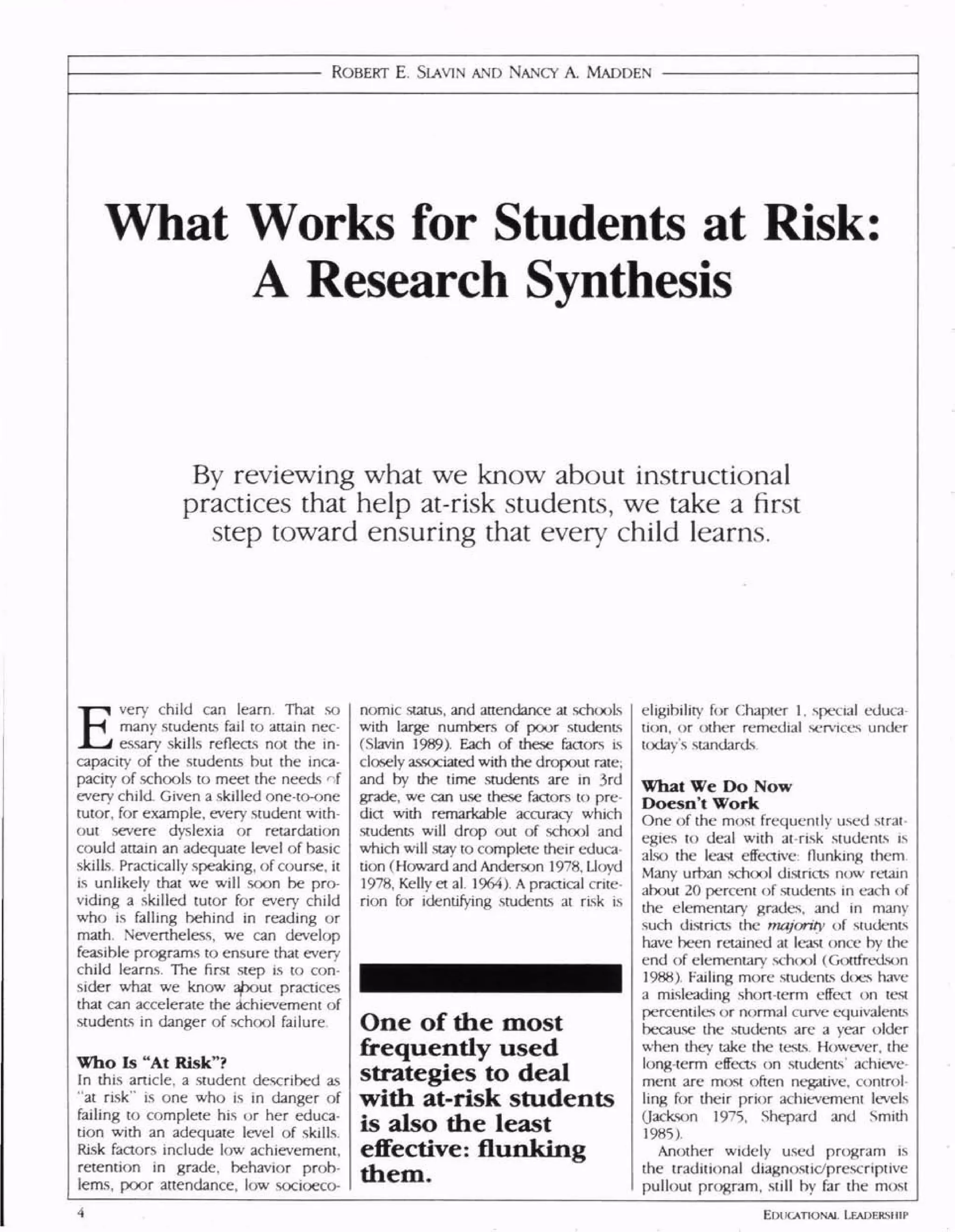
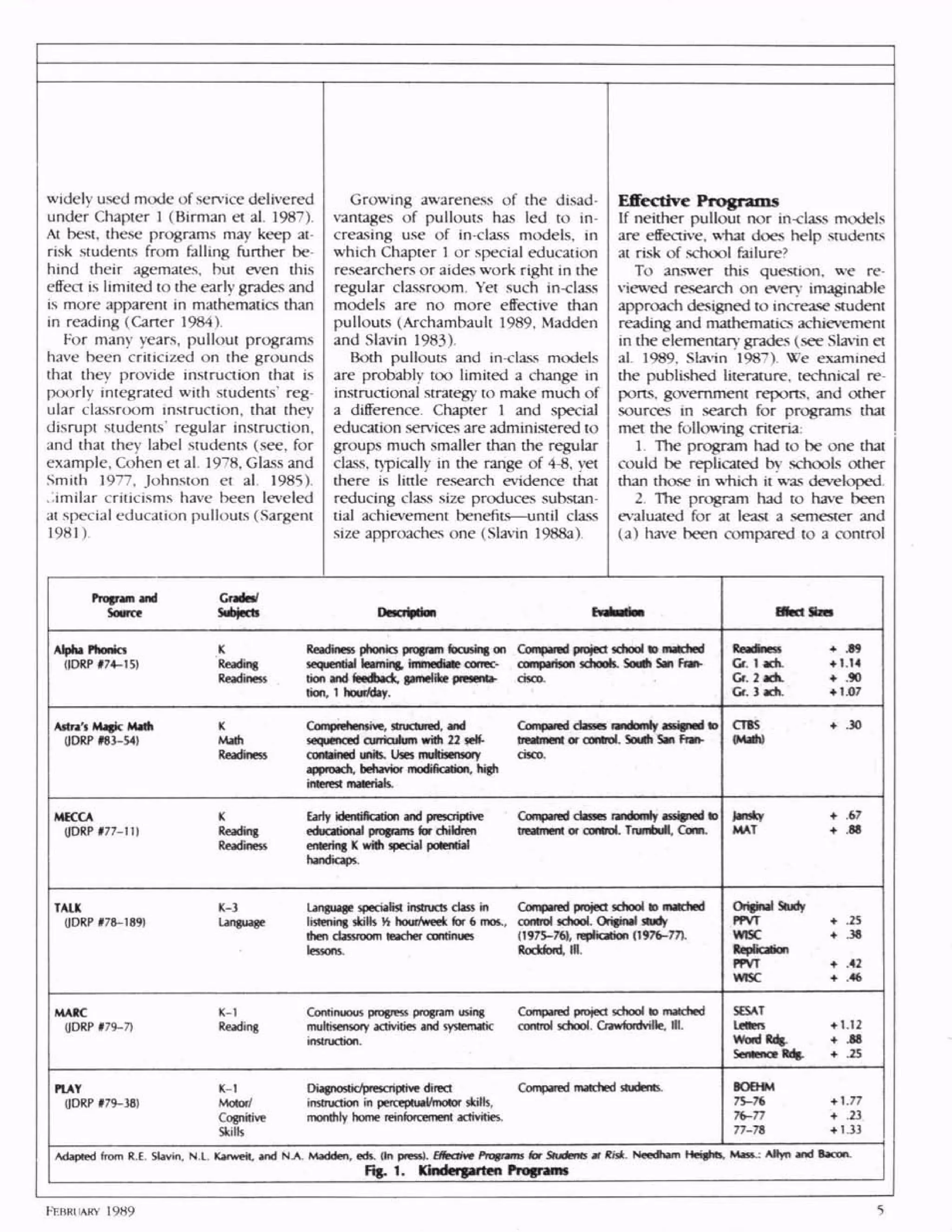
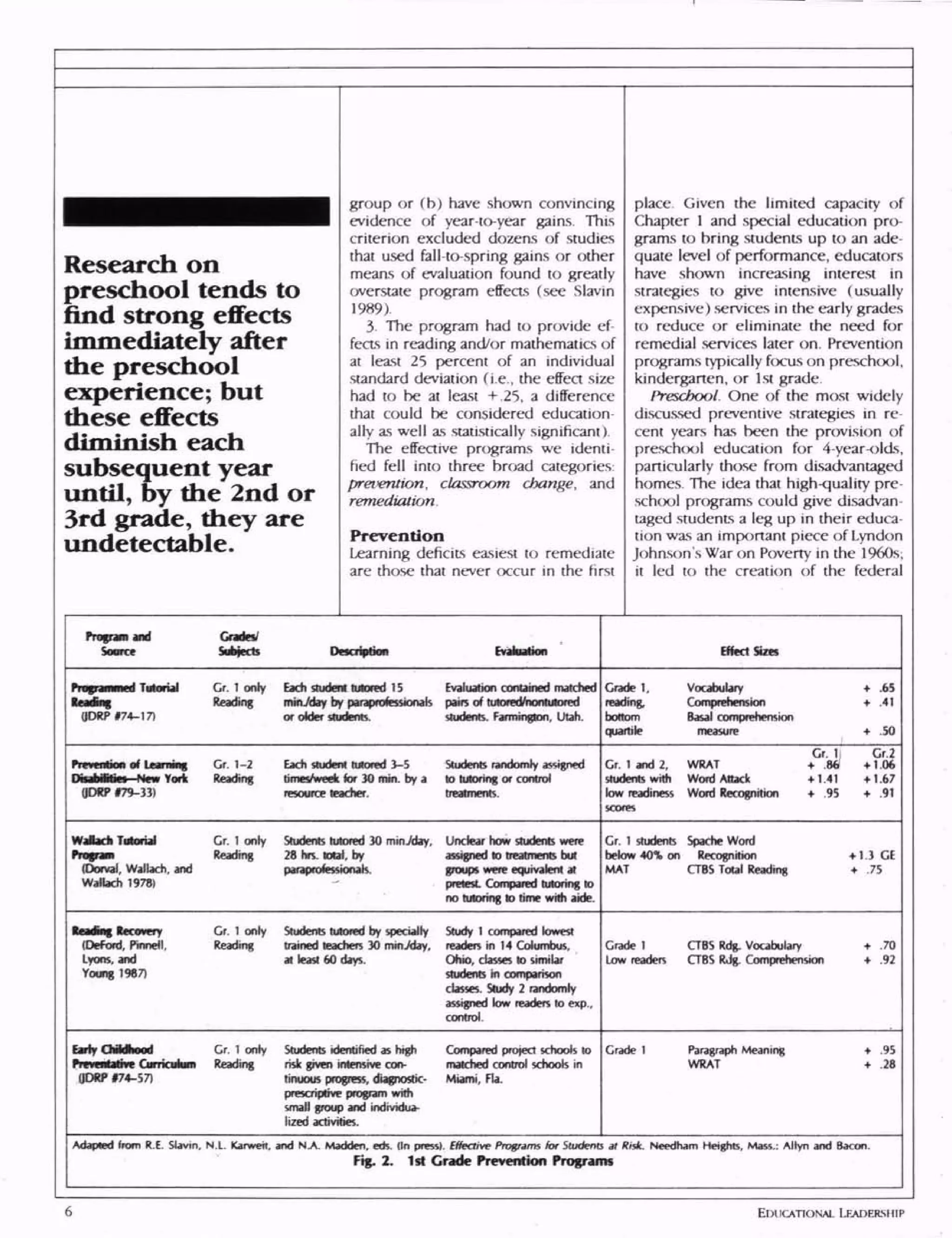
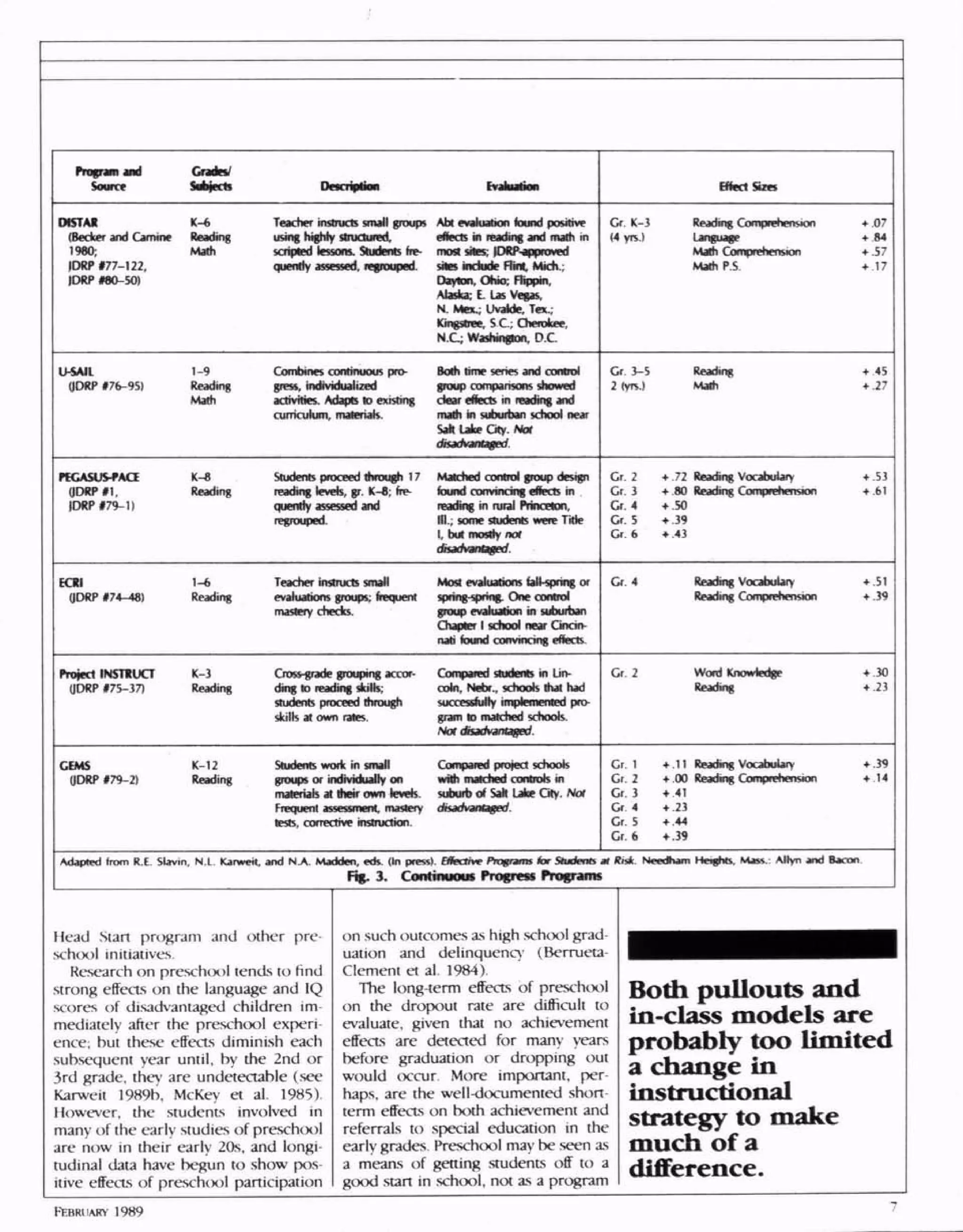
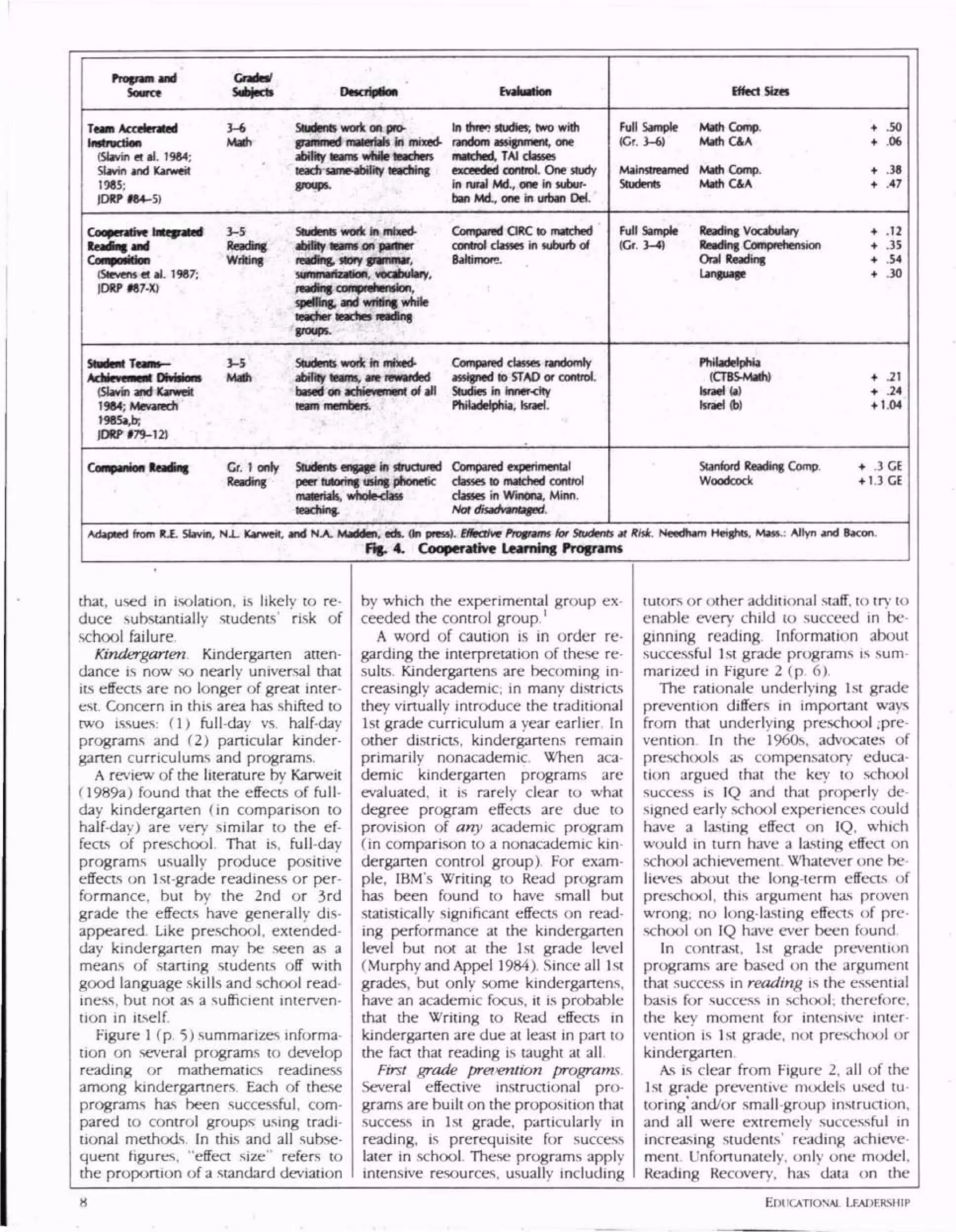
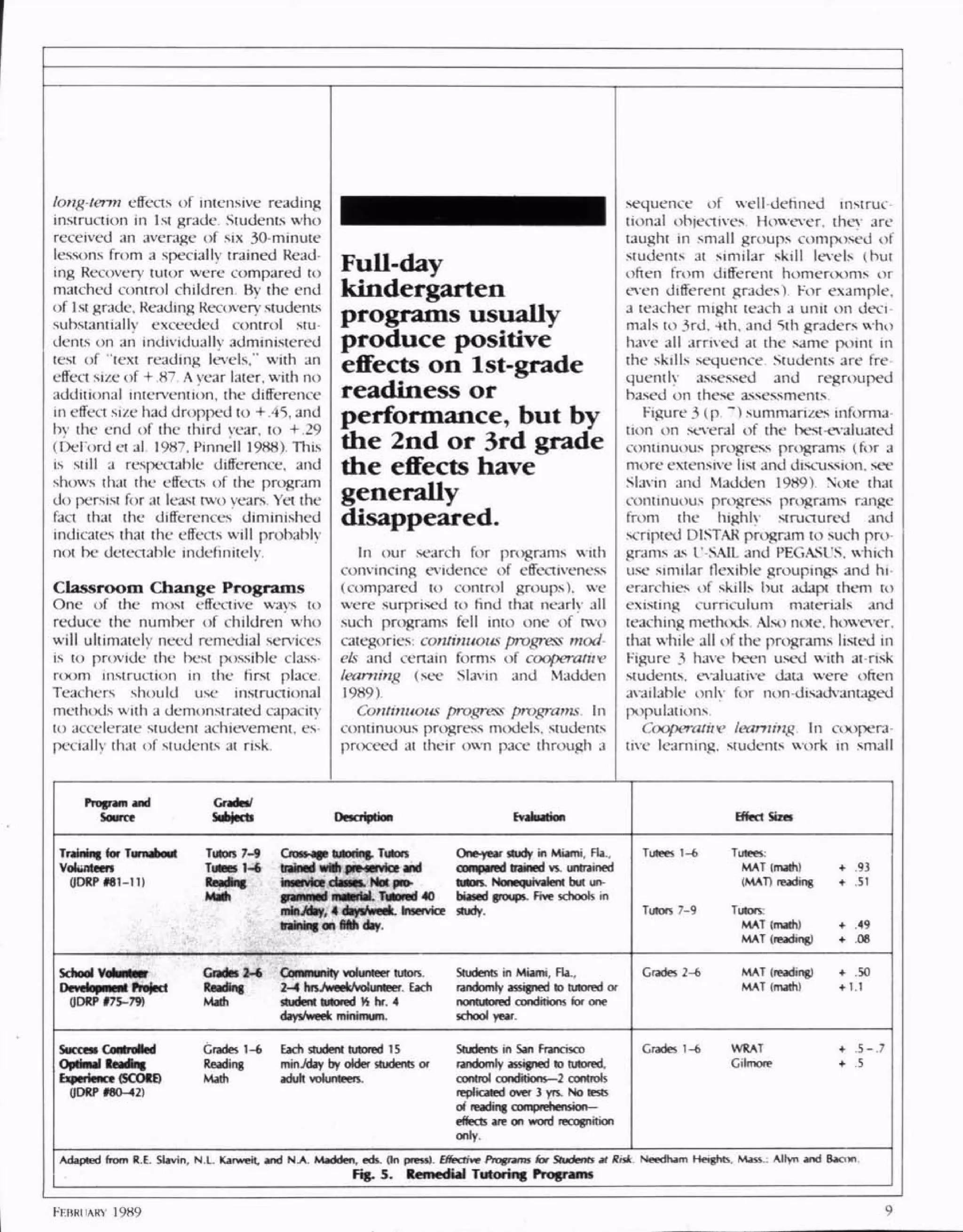
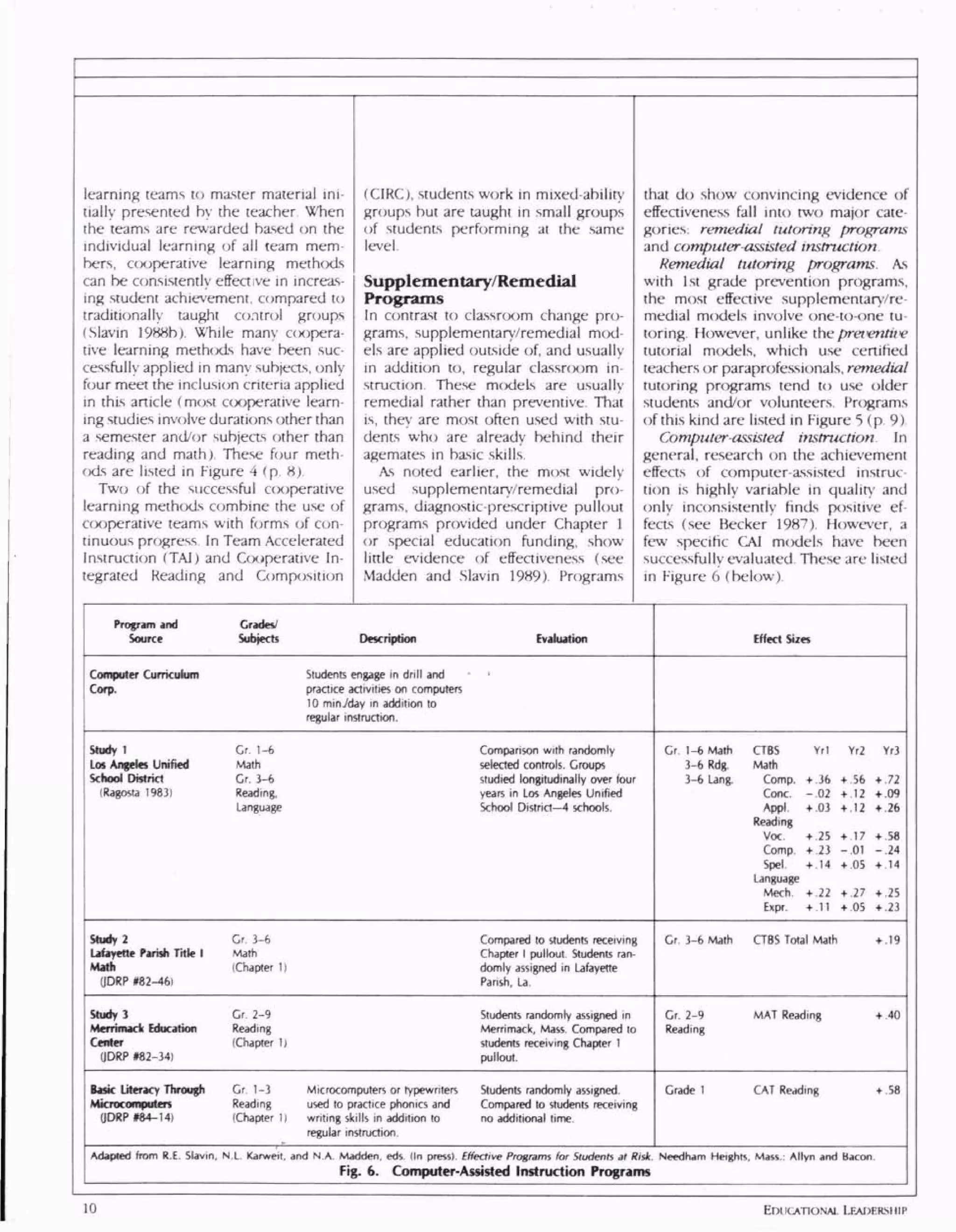
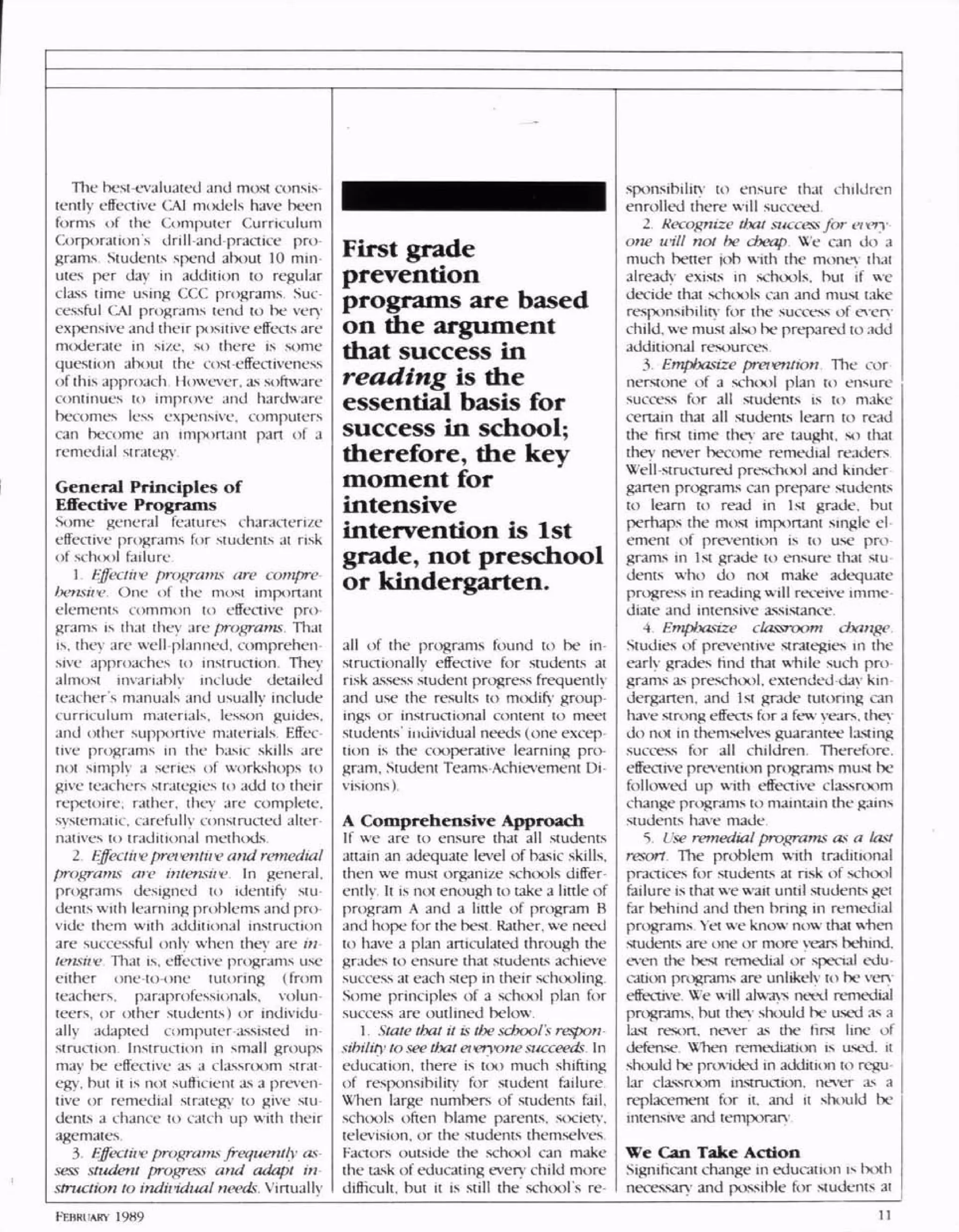
![risk of school failure (see p. 14, this
issue) We know we can do much
better with students at risk, that we can
begin to consider success in sch<x>] as
the birthright of virtually every child
While there is still more we must
learn, we know enough today to take
action. We can do no less for our most
vulnerable children.D
Authors' note Thi.s article was written
under funding from the Office of Educa
tional Research and Improvement. IS De
partment of Education (No OERI-G-86-
0006). However, any opinions expressed
are the authors and do not represent OERI
positions or policy
1 To get an idea of what effect size
means, consider that an effect si/e of -t-1 0
would indicate that a program increased
students scores by the equivalent of ap
proximately 100 points on the SAT Verbal
or Quantitative .scales, by two stanines, or
by 15 IQ points However, the effect sixes
given in the tables are only rough approx
imations (see Slavin et al 19H9)
"JDRP numbers refer to programs rec-
ogni/ed as effective by the U S Department
of Education s Joint Dissemination Review
Panel and listed in its publication. Educa
tional Programs That Work ( available
from Sopris West. 1120 Delaware Ave ,
Longmont. CO 80501)
References
Archambault. FX (1989) "Instructional
Setting and Other Design Features of
Compensatory Education Programs In
Effectiiv Programs for Students at Risk.
edited by R.E. Slavin, N I. Karweit, and
N.A. Madden Needham Heights. Mass.:
Allyn and Bacon
Becker, IIJ U98"1 ) The Impact of Com
puter Use on Learning What Research
Has Shou-n and What It Has Not ( Tech
Rep No 18). Baltimore. Md The Johns
Hopkins University Center for Research
on Elementary and Middle Schools
Berrueta-Clement, JR. LJ. Schweinhart,
W S Barnett. AS Epstem. and D P
Weikart (1984) Changed Liivs Ypsi-
lanti, Mich High/Scope
According to research, what are the most effective ways to help at-risk students?
~ i commonly used strategies flunking and pullout programs are ineffective at
;ing lasting achievement gains. The long-term effects of flunking on achieve-
e negative. Pullout programs, at best, do no more than kelp at-risk students
arty grades from falling further behind their peers.n> - means of preventing learning deficits, preschool and extended-day kinder
garten have not shown lasting effects on achievement. Disadvantaged children tend
i .. ;^ r,UKj language and IQ scores i "^'mMv after the experience, but
According to research, what are me niu*,_..~-... -Two commonly used strategies flunking and pullout programs are ineimuyc ...
producing lasting achievement gains. The long-term effects of flunking on achieve
ment are negative. Pullout programs, at best, do no more than kelp at-risk students
in the early grades from falling further behind their peers.As a means of preventing learning deficits, preschool and extended-day kinder
garten have not shown lasting effects on achievement. Disadvantaged children tend
to show improved language and IQ scores immediately after the experience, but
these effects wash out by the 2nd or 3rd grade. Preschool and extended-day
kindergarten may get students off to a good start in school, but these programs in
isolation are unlikely to reduce students' risk of school failure.
*" «*« does work for at-risk students?grade prevention programs that apply intensive resoi».e .s and/or small-group instruction, are extremely successful in increasing
students' reading achievement (fig. 2). Reading Recovery, the one model with data
on long-term effects, produced effects that persisted for at least two years.
~ ' ructional methods that accelerate student achiev- " ' oweciall
at risk, include continuous progress models (fig. 3
>pternentary/remedial programs that have proven effective include remedial
tutoring programs (fig. S) and some models of computer-assisted instruction (fig. 6).
' """Holes characterize effective programs for students at-risk:
...Jergarten nmy g^* ,solation are unlikely to reduce students' risk ot scnoui id,,-.-
So what does work for at-risk students?~ First grade prevention programs that apply intensive resources, usually includ-
tutors and/or small-group instruction, are extremely successful in increasing
students' reading achievement (fig. 2). Reading Recovery, the one model with data
on long-term effects, produced effects that persisted for at least two years.
Instructional methods that accelerate student achievement, especially that of
students at risk, include continuous progress models (fig. 3) and cooperative learning
programs (fig. 4)Supplementary/remedial programs that have proven effective include remedial
tutoring programs (fig. 5) and some models of computer-assisted instruction (fig. 6).
Some general principles characterize effective programs for students at-risk:
Effective programs are comprehensive and include teacher's manuals,
lum materials, lesson guides, and other supportive materials.Effective preventive and remedial programs are intensive, using one-to-one
tutoring or individually adapted computer-assisted instruction.
Effective programs frequently assess student progress and modify groupings or
instructional content to meet students' individual needs.
Birman, BF. ME Orland. RK lung. RJ
Anson. G.N Garcia, MT Moore, J.E
Kunkhouser. DR. Mornson. BJ Turn-
hull, and E.R. Reisner (198") The Cur
rent Operation of the Chapter / Pro
gram Washington. DC. Office of
Educational Research and Improvement,
U.S. Department of Education
Carter, I. F (198-1) "The Sustaining Effects
Study of Compensatory and Elementary
Education Educational Researcher H,
"4-13
Cohen, E , J Intilli, and S. Rohbtns (19~"H)
Teachers and Reading Specialists
C<x)oeration or Isolation:1 Reading
Teacher 32 281 28"
DeFord, DE. G.S. Pinnell, C.A I.vons. and
P Young (198") Ohio's Reading Recor
er Program Volume Vtf. Report of the
Eolloii'-l jp Studies Columbus Ohio
State University
Glass, G V , and M I, Smith (19"~> Pullout
in Compensatory Fducation Washing
ton, DC IS Department of Health,
Education, and Welfare
Gottfredson, G.D (April 1988) "You Get
What You Measure You Get What You
Don't. Higher Standards, Higher Test
Scores, More Retention in Grade Paper
presented at the annual convention of
the American Educational Research As
sociation, New Orleans
Howard. MAD . and RJ Anderson (19~8)
Early Identification of Potential School
Dropouts A Literature Review Child
Welfare 52: 221 231
Jackson, GB (I9"5) The Research Evi
dence on the Effects of Grade Reten
lion " Rei'ieu' of Educational Research
45. 613-635
Johnston, P . R Allington, and P Afflerbach
(1985) "The Congruence of Classrcxim
and Remedial Instruction F.lementan
SchoolJournal 85 465-4"~
Karweit. N I. (I989a) "Effective Kindergar
ten Programs and Practices for Students
at Risk of Academic Failure " In Effectiiv
Programsfor Students at Risk, edited by
RE. Slavin. N I.. Karweit. and N.A Mad
den Needham Heights, Mass : Allyn and
Bacon
Karweit. N1. (1989h) "Preschool Pro
grams for Students at Risk of Sch<x>l
Failure In Effective Programs for Stu
dents at Risk, edited by R E Slavin, N I.
Karweii. and N.A. Madden Needham
Heights. Mass Allyn and Bacon
Kelly. FJ , DJ Veldman, and C McGuire
(1964) Multiple Discriminant Predic
lion of Delinquency' and Schtxjl Drop-
outs Educational and I'sychological
Measurement 24 535-544
12 EDUCATIONAL LEADERSHIP](https://image.slidesharecdn.com/what-works-for-students-at-risk-140612001530-phpapp01/75/What-works-for-students-at-risk-9-2048.jpg)
